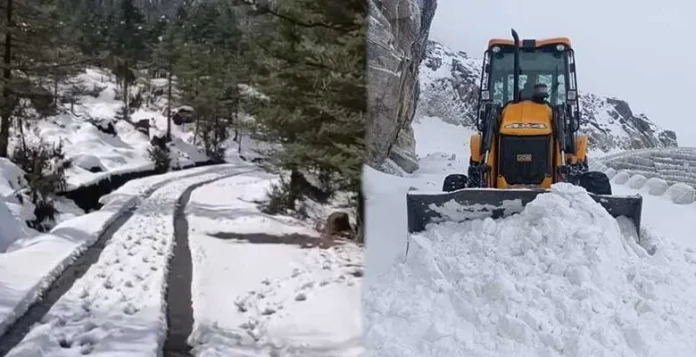Sikkim has been blanketed by heavy snowfall over the past few days, bringing both scenic beauty and severe disruptions to daily life. Among the most notable impacts is the closure of the strategic Nathu La Pass, a critical route that connects Sikkim to China’s Tibet Autonomous Region. The heavy snow accumulation has rendered the pass impassable, leaving tourists and traders stranded and prompting authorities to issue safety advisories.
Snowfall Brings Joy and Challenges
While the snowfall has transformed Sikkim’s landscape into a winter wonderland, it has also posed significant challenges. Residents in high-altitude areas, including Lachung, Lachen, and Tsomgo Lake, are facing difficulties due to blocked roads, disrupted communication lines, and power outages.
The tourism industry, a major economic driver in the state, has experienced a mixed impact. On one hand, the snow-clad mountains have attracted tourists eager to experience Sikkim’s winter charm. On the other hand, road closures, including the blockage of Nathu La, have led to canceled plans and disappointed visitors.
Nathu La Pass: A Vital Corridor Sealed Off
The closure of Nathu La Pass, a vital link for trade and travel, is particularly concerning. Located at an elevation of 14,140 feet, the pass is prone to heavy snowfall during winter. This time, the snow accumulation has been exceptionally heavy, making it unsafe for vehicles to navigate the route.
Authorities have halted all movement through the pass, and traders relying on cross-border commerce are facing losses. The Indian Army and the Border Roads Organisation (BRO) are working tirelessly to clear the snow, but the challenging weather conditions have slowed their progress.
Safety Warnings Issued
Local authorities have urged residents and tourists to exercise caution. The Sikkim government has advised against unnecessary travel to high-altitude areas until the weather improves and roads are cleared. Tourists heading toward Tsomgo Lake, Baba Mandir, and Nathu La have been asked to stay updated on weather and road conditions before planning their journeys.
District officials have also set up emergency response teams to provide assistance in case of accidents or health emergencies. Medical teams are on standby, and rescue operations have been mobilized to help those stranded due to snow blockades.
Impact on Daily Life
The heavy snowfall has not only affected transportation but also led to disruptions in essential services. Power outages have been reported in remote villages, and the supply of fresh produce has slowed down. Schools in certain areas have been closed, and businesses have faced temporary shutdowns due to accessibility issues.
Residents have been seen stocking up on essentials, as further snowfall is predicted in the coming days. The Sikkim State Disaster Management Authority (SSDMA) is closely monitoring the situation and coordinating relief efforts.
Tourists’ Mixed Reactions
Tourists visiting Sikkim during this period have expressed a range of emotions. While some have marveled at the breathtaking views of snow-covered peaks, others have faced difficulties due to road closures and delays in their travel plans.
A group of tourists from Delhi shared their experience: “We came here expecting snowfall, but we didn’t anticipate being stuck in our hotel for two days. It’s beautiful, but we hope the roads open soon so we can visit Tsomgo Lake and Nathu La.”
Future Outlook
Meteorologists have forecasted more snow in the coming days, with temperatures expected to remain below freezing in many parts of Sikkim. The administration is on high alert, with snow-clearing operations continuing round the clock.
While the snowfall has brought seasonal beauty to Sikkim, the disruptions it has caused serve as a reminder of the region’s vulnerability to harsh weather. For now, residents and tourists alike are bracing for more snowy days ahead, hoping for a swift return to normalcy.
As Sikkim battles the elements, the resilience of its people stands out, reminding all of the delicate balance between nature’s wonders and its challenges in the Himalayan region.




